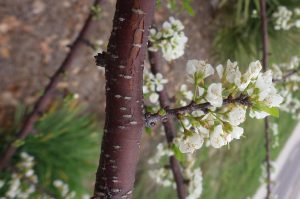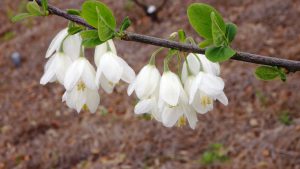Historically, nothing said spring had arrived any better than a flowering dogwood tree. It remains a favored tree in southern landscapes. Sometimes you may see an occasional dogwood in bloom in the local pine forests. However, it is very rare to see one in bloom in the north Florida landscape. While Dogwood Anthracnose, a fungal disease affecting dogwoods in the higher elevations along the Appalachian Mountains is often blamed, it is not the cause for dogwood decline in our part of northeast Florida.

Powdery Mildew
The decline of dogwood in our area is more than likely a combination of the narrow site requirements necessary for dogwoods to thrive, climate, and powdery mildew. First, dogwoods have always had a narrow set of site conditions that they needed to flourish. Northeast Florida is the southernmost extent of their natural range and to grow well they need moist but well drained acidic soil, along with the cooling dappled shade provided by taller but not overpowering trees. Often these trees were tall pines that provided the right amount of filtered sun, and slightly cooler soil conditions that dogwoods needed. Slowly over time the climate has warmed slightly, and many newer landscapes do not have the room for stands of tall pine trees.
The other factor affecting both native and cultivated dogwoods is powdery mildew. Powdery mildew has been documented as a disease of dogwoods as far back as 1887 but it was considered rare until around 1994, when powdery mildew appeared as a major pest throughout the southeast on native, landscape and nursery grown trees. Researchers are still not sure what changed to make powdery mildew a frequent and severe pest on dogwoods.
The symptoms of powdery mildew on leaves are easy to see. The symptoms start out as spots or patches of whitish powdery growth, usually on the leaves. These spots quickly enlarge, turning into a dusty white or gray coating. The symptoms usually appear as minor blemishes as the leaves emerge in the spring. As the season progresses the damage becomes more evident as the leaves appear scorched with brown margins.
While fungicides are effective for powdery mildew when applied at the first incidence of symptoms. It is difficult apply the fungicide into the canopy of the trees. There are very few pesticide applicators that have the equipment necessary to apply the fungicide safely and at a reasonable cost as the fungicides need to be applied at regular intervals. The best bet for the reintroduction of flowering dogwood is the breeding of resistant varieties. In more temperate climates not to far north, landscapers are having a lot of success with breeding Kousa dogwood x Flowering dogwood hybrids that have proved very resistant to powdery mildew. Unfortunately, Kousa dogwoods, and their hybrids have not done well in our climate. The best hope we have is that resistant flowering dogwood cultivars will be developed for our area. Three that may be worth a try are ‘Appalachian Joy’, ‘Appalachian Mist’, and ‘Appalachian Snow’. The only drawback to these highly resistant varieties is that they were developed in Tennessee and may not acclimate to our warmer humid summers.
Another solution that may fill the void left by declining dogwoods is to replace them with other similar white spring flowering trees.
Dogwood Alternatives


The Carolina Silverbell is a small understory tree maturing at 25-30 feet that is native to the Southeast. In the spring dainty bell shaped flowers appear on last year’s branches. It prefers partial shade and a well-drained moist soil. It provides some interest in the fall as well with early yellow fall color.
Chickasaw Plum is a small native tree growing to 20- 25 feet at maturity. The Chickasaw plum blooms in early spring with many fragrant small white flowers. The tree does produce small plums that are used in making jelly. Wildlife also enjoy eating the fruits. Some report the branches can be thorny but the one growing at the Duval County Extension office is free of thorns.
The Fringe tree is also called Grancy Gray-beard and Old-man’s beard because of its unusual flowers. The tree grows fairly slow, so it is not a tree for the impatient. It should be planted in full sun or full sun with late afternoon shade. Its cousin the Chinese Fringe tree is just as showy. The difference is the Chinese Fringe tree flowers emerge after the leaves.
Lastly is Walter viburnum. It is a native evergreen shrub or small tree that grows to a height of about 20-


25 feet. However, there are varieties that are dwarf as well. Make sure you are assured which tree form you are purchasing. The small white blooms cover the plants in white blooms for a few weeks in late winter/ early spring. They are also tolerant of wetter soil as they are native to wetland edges.
With powdery mildew and a warming climate, will continue to be the most serious issues facing flowering dogwood use in the landscape, you may want to try incorporating one or more of these trees into your landscape. Hopefully new breeding programs will once again supply resistant dogwood cultivars that one day we will be able to incorporate back into our landscapes.
 1
1
